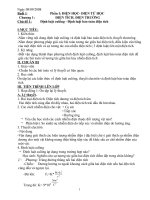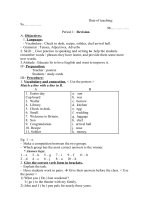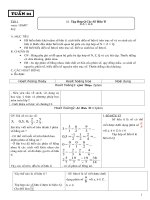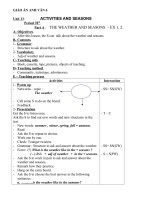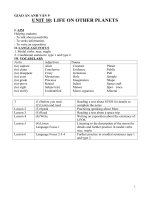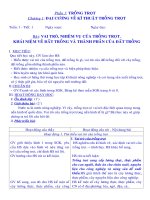Giáo án Tiếng anh9 Học kì 2(unit 10)
Bạn đang xem bản rút gọn của tài liệu. Xem và tải ngay bản đầy đủ của tài liệu tại đây (170.34 KB, 18 trang )
GIÁO ÁN ANH VĂN 9
UNIT 10: LIFE ON OTHER PLANETS
I. AIM
Helping students:
- To talk about possibility
- To seeks information.
- To write an exposition
II. LANGUAGE FOCUS
1. Modal verbs: may, might
2. Conditional sentences: type 1 and type 2.
III. VOCABULARY
Verbs Adjectives Nouns
(to) capture
(to) claim
(to) disappear
(to) exist
(to) grade
(to) prove
(to) sight
(to) terrify
Alien
Conclusive
Crazy
Mysterious
Precious
Round
Subject (to)
Unidentified
Creature
Evidence
Gemstone
Hole
Imagination
Infant
Meteor
Micro organism
Planet
Public
Pull
Sample
Shape
Space craft
Spot trace
Mineral
3 (1) Before you read
(2) Listen and read
Reading a text about UFOS for details to
complete the notes
Lesson 2 (3) Speak Practicing speaking about Mars
Lesson 3 (5) Read Reading a text about a space trip
Lesson 4 (6) Write Writing an exposition about the existence of
UFOS.
Lesson 5 (4) Listen
Language Focus 1
Listening to the description of the moon for
details and further practice in modal verbs
may, might.
Lesson 6 Language Focus 2-3-4 Further practice in conidial sentences type 1
and type 2
1
UNIT 10: LIFE ON OTHER PLANETS
Lesson 1: Section - Before you read (page 83)
Period 63: - Listen and read (page 83-84)
I. AIM
Reading a text about UFOs for details to complete the notes.
II.OBJECTIVE
By the end of the lesson, students will be able to know more about UFOs.
III. TEACHING AIDS
Text books, pictures.
PROCEDUCE
Stage Steps/ Activities Work
arrangement
Warm-up
Pre-reading
* Guessing words:
- Have students guess three words.
- Give students the number of the letters of each word and give
the definitions so that students can guess the words.
1) ----------------------------------------------------------------
* This word has 12 letters. It is the opposite of identified.
2) --------------------------------------------------------------
* This word has 6 letters. It means moving through the air as a
birth does.
3) ---------------------------------------------------------------
* This word has 7 letters. It is in form. It means a thing that can
be seen or touched.
* Answer keys:
1. Unidentified
2. Flying UFOs (Vật thể bay không xác định)
3. Objects
* Chatting:
- Show the picture on page 83 to the students and ask them some
questions about UFOs
* What can you see in the pictures?
* What do we call them in Vietnamese?
* Do you know another word for UFOs?
(flying saucer)
* Do you thing they really exist?
* Have you ever seen any films on UFOs?
* Do you want to see a UFO? What do you want to know about
UFOs?
* If you saw an UFOs, what would you do?
I. Pre- teach vocabulary
- spacecraft (n): tàu vũ trụ (picture)
- meteor (n): sao băng (visual, picture)
- evidence (v): bằng chứng
(definiton: anything that makes clear, shows or proves)
- alien (n): người ở hành tinh khác
T-whole class
T-whole class
T-whole class
2
While
reading
(definition: person on other planets)
- capture (v): bắt
(synonym: catch (by force) arrest)
- device (n): dụng cụ, thiết bị (translation)
- claim (v): đòi quyền, nhận là (translation)
* Checking vocabulary: what and where
- Have students repeat the words chorally then rub out word by
word but leave the circles. Remember to let students repeat
before and after rubbing out each word.
- Go on until students can remember the words
- Get students to write the words again in the correct circles.
II. Guessing the meaning of the words:
- Get students to read the text and find the words in the text that
have the meanings given in * 2 a on page 84:
- Ask students to work in pair.
- Give feedback
* Answer keys:
1. proof, support = evidence
2. falling star or shooting star = meteor
3. unknown/strange people or thing = aliments
4. bringing together or gathering = collecting
5. caught as a prisoner = captured
6. because impossible to see = disappeared
III. Complete the notes
- Have students to do exercise 2b on page 84
- Get students to read the text again and complete the notes. They
have to work individually then compare with their partners.
- Call on some students to read aloud their sentences.
* Answer keys:
UFO Sightings:
a) An aircraft , a weather balloon or a meteor can be mistaken
for a alien spacecraft
b) In 1947, a pilot saw nine large round objects traveling at
about 2.800 meters an hours.
c) There were over 1.500 UFO sightings worldwide in 1952
d) In 1954, a woman and her children saw a UFO above their
house.
e) A farmer saw an egg- shaped object in one of his fields
and also aliens collecting soil samples in 1964.
f) In 1971, two men claimed they were captured by aliens
Pair work
Group work
Individual
work
Pair work
3
Spacecraft
Spacecraft
Captur
e
Alien
Claim
Device
Meteor
Post reading
Home work
and taken aboard a spacecraft.
g) A pilot and his plane disappeared after sighting an UFO in
1978.
h) In 1981, a Frenchman reported that he saw a plate – like
device at a treetop 30 meters away from his garden.
* Discussion:
- Have the whole class discuss the topic “UFOs”
- Choose good students to be the leader.
- Get the leader to make a summary of the evidence of the
existence of UFOs and then discuss with his/ her friends.
- Give the leader some questions for him / her to ask his/ her
friends.
* Do you believe in Kenneth Arnold, or the woman who saw a
UFO above her house?
* Have you ever seen a picture of an alien? Can you imagine
what the aliens are like? Are they small or big? Are they
intelligent? (If yes) Why do you think so?
- Have students write the notes on page 84 in their notebook.
Whole class
4
UNIT 10: LIFE ON OTHER PLANETS
Lesson 2: Section - Speaker (page 85)
Period 64:
I. AIM
Practice speaking about Mars.
II. OBJECTIVE
By the end of the lesson, students will be able to talk to one another about what they
think there might be on Mars, on the moon and on other planets.
III. TEACHING AIDS
Text books, pictures, posters.
PROCEDUCE
Stage Steps/ Activities Work
arrangement
Warm-up
* Word square
S E A R T H
M U M E R C
U R N S A U
S S R U B R
A A R V C Y
M O O N T S
Earth
Sun
Mars (Hoả)
Moon
Mercury (Thủy)
- Ask students some questions about the solar system.
* Which planet is the nearest to the sun? (M)
* Which is the biggest?
* Which is the hottest?
I. Pre-teach vocabulary
- microorganism (n): vi sinh vật (translation)
- gemstone (n): đá quý (relia)
- sparkling (adj): lấp lánh (realia)
- creature (n): sinh vật (translation)
- trace (n): dấu vết (visual)
- mineral (n): khoáng sản (example)
* Checking vocabulary: Rub out and remember
- Rub out the new word one at a time. Each time you rub out the
word in English, point to the Vietnamese translation and ask
students to repeat in English. When all the English words are
rubbed out go through the Vietnamese list and get the whole class
to call out the English words.
II. Revision of model verbs: may – might
* Form: May/might + infinitive
* Use: We use may, might to talk about present or future
possibility.
- Might is normally a little less sure than may.
T-whole class
5
Production
II. Matching
- Set the scene: A space tourist traveled to Mars, he saw many
things there and noted them down. These are drawing of things.
Try to guess and match the drawings with their names.
- Number from 1 to 7 from left and right.
* Answer keys:
1) Minerals]
2) Water
3) Mountains
4) Plants
5) Little creatures
6) Gas
7) Gemstone
II. Drill
- Use the drawing to drill
* Exchange: what’s this?
This may be water on Mars.
1. What are they?
They may be minerals on Mars
2. What are they?
They might be plants on Mars
3. What’s this?
This may be gas on Mars
4. What are they?
They may be gemstones on Mars.
5. What are they?
The may be little creatures.
III. Practice the dialogue
- Have students practice the dialogue between Nam and Hung on
page 85.
- Call on some pairs of students to practice the dialogue.
- Correct their pronunciation.
- Have all students work in pairs to practice the dialogue.
* Dialogue
Nam: What do these drawing say, Hung?
Hung: There might be water on Mars.
Nam: And what about those back sparkling spots on the right
corner?
Hung: Well, they might be traces of gemstones. There may be a
lot of precious stones on Mars.
IV. Matching dialogue
- Have students make up similar dialogue about the drawings,
using the cues in 3a.
* Sample:
You: What do these drawing say?
Your friend: These may be mountains on Mars.
Whole class
6
Homework
You: And what about the red signs on the left corner?
Your friend: Well, they might be gas on Mass
- Call on some pairs of students to practice their dialogue before
the class.
- Give feedback
* Discussion:
- Give students the topic “What may there be on Mercury/on the
moon/ on Mars?”
- Ask students to write the dialogue in their notebooks.
Individual
work
----------------------------------------------------------------------
UNIT 10: LIFE ON OTHER PLANETS
Lesson 3: Section - Read (page 86-87)
Period 63:
I.AIM
Reading a text about a space trip.
II.OBJECTIVE :
By the end of the lesson, students will be able to understand the text about a space trip.
III.TEACHING AIDS
Text books, pictures.
PROCEDUCE
Stage Steps/ Activities Work
arrangement
Warm-up
Pre reading
* Chatting:
- Prepare some lectures of a spaceship or of the first travel of man
to the moon
- Show students that picture and ask them some questions to
involve students in the topic of the lesson.
* Do you want to travel?
* Have you ever traveled in our country or broad?
* Have you ever dreamed of a trip to space?
* Do you want to be an astronaut?
* Do you think traveling into space takes a lot of money?
I. Pre-teach vocabulary
- push – up (v): hít đất (mime)
- orbit (n/v:) quĩ đạo/di chuyển theo quĩ đạo
(visual/picture/translation)
- totally (adv): hoàn toàn (synonym: completely)
- marvelous (adj): tuyệt diệu, kỳ diệu (synonym: wonderful)
- physical condition (n): tình trạng thể chất, thể lực (translation)
* Checking vocabulary: Slap the board
- Write the new words all over board, each word in one circle.
T-whole class
7



